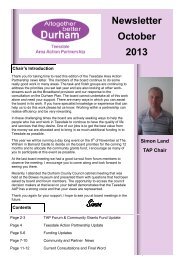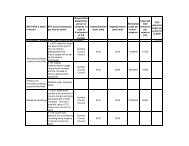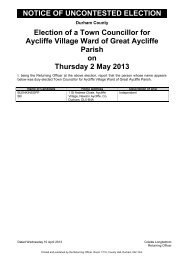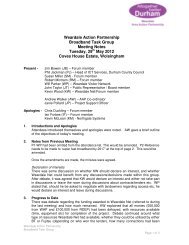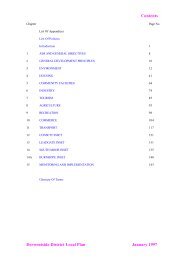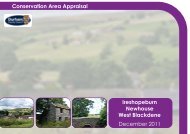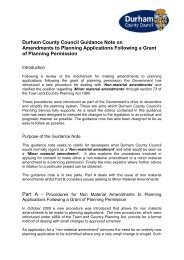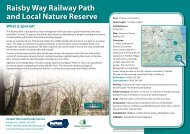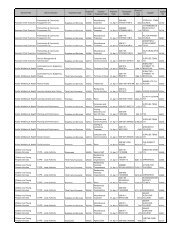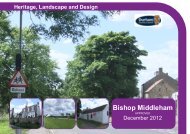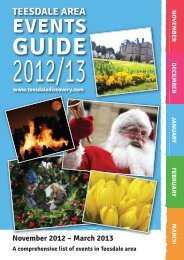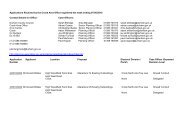SECTION 3.0 - Durham County Council
SECTION 3.0 - Durham County Council
SECTION 3.0 - Durham County Council
You also want an ePaper? Increase the reach of your titles
YUMPU automatically turns print PDFs into web optimized ePapers that Google loves.
• Paragraph 14 Species protection - Local planning authorities should take<br />
measures to protect species from further decline.<br />
• Natural Areas in the North East Region, English Nature, (1999).<br />
This document promotes<br />
the conservation of wildlife and natural features<br />
throughout the North East of England. It highlights how England is divided into a<br />
series of Natural Areas based upon the distribution of wildlife and natural features,<br />
land use patterns and the human history of each area. Natural Areas are based<br />
upon j oint work with the former Countryside Agency into the characterisation of the<br />
countryside into locally distinctive units called character<br />
areas. The document<br />
indicates that natural areas offer a more effective framework for the planning and<br />
achievement of nature conservation objectives<br />
than administrative boundaries and<br />
are recognised in planning policy. <strong>County</strong> <strong>Durham</strong> contains parts of several Natural<br />
Areas including the North Pennines, Northumbria<br />
Coal Measures, Tees Lowlands<br />
and the <strong>Durham</strong> Magnesian Limestone Plateau Natural Areas. For key themes<br />
including earth heritage, freshwater, inland rock, bog fen and swamp, woodland,<br />
lowland grassland and heath, upland grassland and heath, maritime areas<br />
the<br />
document describes key features of each area and includes key issues and<br />
objectives. • North Pennines<br />
Area of Outstanding Natural Beauty (AONB), Geo-<br />
diversity Audit and Action Plan, 2004-2009, North Pennines AONB<br />
Partnership, (2004).<br />
The<br />
principal aim of this plan is to guide the conservation and interpretation of the<br />
geological features of this world renowned area for the study of earth science. It<br />
is<br />
also<br />
intended to support the development of sustainable ‘geo-tourism’ in the North<br />
Pennines, as part of the North Pennines AONB Partnership Staff Unit’s work as<br />
managers of the European Geo-Park status for the AONB.<br />
The Action Plan sets out a vision, “By 2014, the variety of geological features<br />
and<br />
processes that underpin and influence the landscape, biodiversity and culture<br />
of<br />
the North Pennines AONB will be well protected and well managed. This means<br />
that the most important and typical sites and features are recognised<br />
and<br />
conservation measures are in place. Those sites and features that<br />
have played the<br />
most important roles in the development of geological science or in the cultural<br />
heritage of the North Pennines have been consolidated and interpreted.<br />
Management plans for these features are in place and are working<br />
well. The way<br />
the geology of the North Pennines is reflected in its buildings and walls is well<br />
understood and appreciated. Through caring for the area’s geology and realising<br />
its potential for tourism, education and lifelong learning, the AONB has<br />
successfully maintained its status as a European Geo-Park”. The main objectives<br />
of this Geo-diversity Audit and Action Plan can be summarised as:<br />
• To raise awareness of the fundamental importance of geo-diversity in the<br />
sustainable management of the North Pennines AONB.<br />
• To improve knowledge and understanding of the geo-diversity resources<br />
within the AONB.<br />
Page 15 4/15/2009




